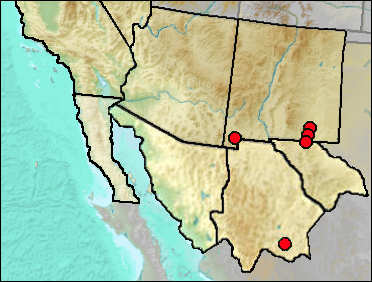Class Mammalia
Order Order Eulipotyphla
Family Soricidae

The genus Cryptotis is represented in our region by a single species (C. parva). Cryptotis differs from Notiosorex and Sorex in having four upper unicuspids (three per side in Notiosorex and five in Sorex). Thus maxillae are relatively easy to identify to genus.
The Least Shrew is primarily a grassland animal, with a few modern records in eastern New Mexico. Modern specimens are known from the vicinity of Bitter Lake in Chaves Co.; Salt Lake, Roosevelt Co.; and Tucumcari Lake, Quay Co. (Frey 2004). Hafner and Shuster (1996) concluded on the basis of allozymic studies that the latter two localities probably represent recent movement from farther east with increased irrigation and a trend toward a more mesic climate. However, the Bitter Lake population was indicated to be relictual from altithermal or Wisconsin times. In any case, the records in the Guadalupe Mountains area represent a relatively small shift to the south; the Howell's Ridge Cave record, however, is far out of the present geographic range.
 The
specimens cited as from MALB loc. 4 in Harris et al. (1973) were later transferred to
UTEP 54 as loc. 4 was split when it was realized that different ages were represented.
The 14C date cited in that paper for what now is UTEP Loc. 54 was on bone
and likely is a bit too young.
The
specimens cited as from MALB loc. 4 in Harris et al. (1973) were later transferred to
UTEP 54 as loc. 4 was split when it was realized that different ages were represented.
The 14C date cited in that paper for what now is UTEP Loc. 54 was on bone
and likely is a bit too young.
Fig. 1. Medial view of the right dentary of the Least Shrew (Cryptotis parva) from the TT II site (UTEP Loc. 54) within Dry Cave, Eddy Co., NM; i1 and m1-2 are present.

Fig. 2. Skull and dentaries of a recent specimen of Cryptotis parva. The fourth unicuspid is visible at the end of the white line on the palate; it is not visible in lateral view. In places, some tissue still adheres to the bone; the angular processes of the dentaries are broken. Scale is in mm.
Sites.
Mid/Late Wisconsin: Animal Fair (Harris 1993c).
Mid/Late Wisconsin/Holocene: Jimenez Cave (Messing 1986).
Late Wisconsin: Muskox Cave (Logan 1981); TT II (Harris et al. 1973); Upper Sloth Cave (Logan and Black 1979).
Late Wisconsin/Holocene: Balcony Room (Harris 1993c); Howell's Ridge Cave (Harris et al. 1973).
Literature.
Frey 2004; Hafner and Shuster 1996; Harris 1993c; Harris et al. 1973; Logan 1981; Logan and Black 1979; Messing 1986.
Last Update: 24 Oct 2013